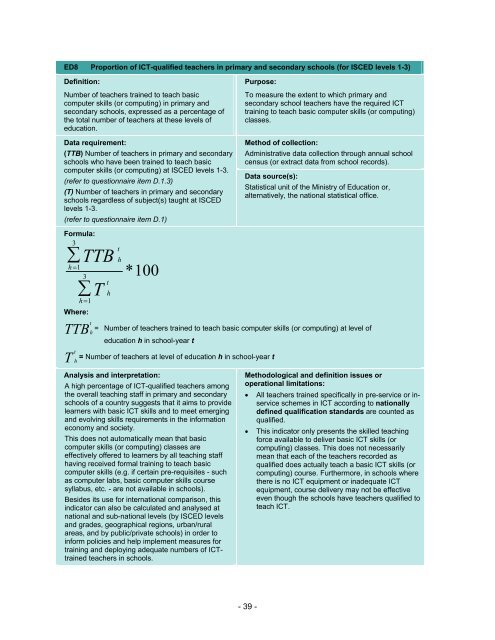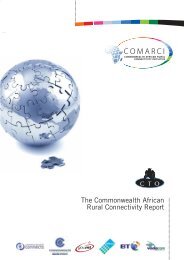Guide to measuring information and ... - unesdoc - Unesco
Guide to measuring information and ... - unesdoc - Unesco
Guide to measuring information and ... - unesdoc - Unesco
You also want an ePaper? Increase the reach of your titles
YUMPU automatically turns print PDFs into web optimized ePapers that Google loves.
ED8 Proportion of ICT-qualified teachers in primary <strong>and</strong> secondary schools (for ISCED levels 1-3)<br />
Definition:<br />
Number of teachers trained <strong>to</strong> teach basic<br />
computer skills (or computing) in primary <strong>and</strong><br />
secondary schools, expressed as a percentage of<br />
the <strong>to</strong>tal number of teachers at these levels of<br />
education.<br />
Data requirement:<br />
(TTB) Number of teachers in primary <strong>and</strong> secondary<br />
schools who have been trained <strong>to</strong> teach basic<br />
computer skills (or computing) at ISCED levels 1-3.<br />
(refer <strong>to</strong> questionnaire item D.1.3)<br />
(T) Number of teachers in primary <strong>and</strong> secondary<br />
schools regardless of subject(s) taught at ISCED<br />
levels 1-3.<br />
(refer <strong>to</strong> questionnaire item D.1)<br />
Formula:<br />
3<br />
TTB<br />
h 1<br />
3<br />
T<br />
h 1<br />
Where:<br />
t<br />
h<br />
t<br />
h<br />
* 100<br />
Purpose:<br />
To measure the extent <strong>to</strong> which primary <strong>and</strong><br />
secondary school teachers have the required ICT<br />
training <strong>to</strong> teach basic computer skills (or computing)<br />
classes.<br />
Method of collection:<br />
Administrative data collection through annual school<br />
census (or extract data from school records).<br />
Data source(s):<br />
Statistical unit of the Ministry of Education or,<br />
alternatively, the national statistical office.<br />
TTB t<br />
= Number of teachers trained <strong>to</strong> teach basic computer skills (or computing) at level of<br />
h<br />
education h in school-year t<br />
T t<br />
= Number of teachers at level of education h in school-year t<br />
h<br />
Analysis <strong>and</strong> interpretation:<br />
A high percentage of ICT-qualified teachers among<br />
the overall teaching staff in primary <strong>and</strong> secondary<br />
schools of a country suggests that it aims <strong>to</strong> provide<br />
learners with basic ICT skills <strong>and</strong> <strong>to</strong> meet emerging<br />
<strong>and</strong> evolving skills requirements in the <strong>information</strong><br />
economy <strong>and</strong> society.<br />
This does not au<strong>to</strong>matically mean that basic<br />
computer skills (or computing) classes are<br />
effectively offered <strong>to</strong> learners by all teaching staff<br />
having received formal training <strong>to</strong> teach basic<br />
computer skills (e.g. if certain pre-requisites - such<br />
as computer labs, basic computer skills course<br />
syllabus, etc. - are not available in schools).<br />
Besides its use for international comparison, this<br />
indica<strong>to</strong>r can also be calculated <strong>and</strong> analysed at<br />
national <strong>and</strong> sub-national levels (by ISCED levels<br />
<strong>and</strong> grades, geographical regions, urban/rural<br />
areas, <strong>and</strong> by public/private schools) in order <strong>to</strong><br />
inform policies <strong>and</strong> help implement measures for<br />
training <strong>and</strong> deploying adequate numbers of ICTtrained<br />
teachers in schools.<br />
Methodological <strong>and</strong> definition issues or<br />
operational limitations:<br />
All teachers trained specifically in pre-service or inservice<br />
schemes in ICT according <strong>to</strong> nationally<br />
defined qualification st<strong>and</strong>ards are counted as<br />
qualified.<br />
This indica<strong>to</strong>r only presents the skilled teaching<br />
force available <strong>to</strong> deliver basic ICT skills (or<br />
computing) classes. This does not necessarily<br />
mean that each of the teachers recorded as<br />
qualified does actually teach a basic ICT skills (or<br />
computing) course. Furthermore, in schools where<br />
there is no ICT equipment or inadequate ICT<br />
equipment, course delivery may not be effective<br />
even though the schools have teachers qualified <strong>to</strong><br />
teach ICT.<br />
- 39 -
















